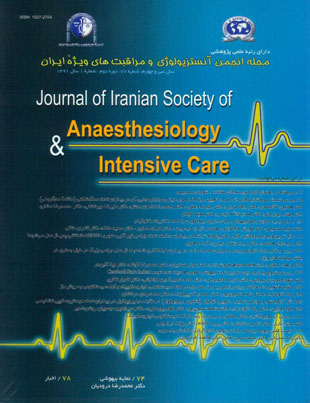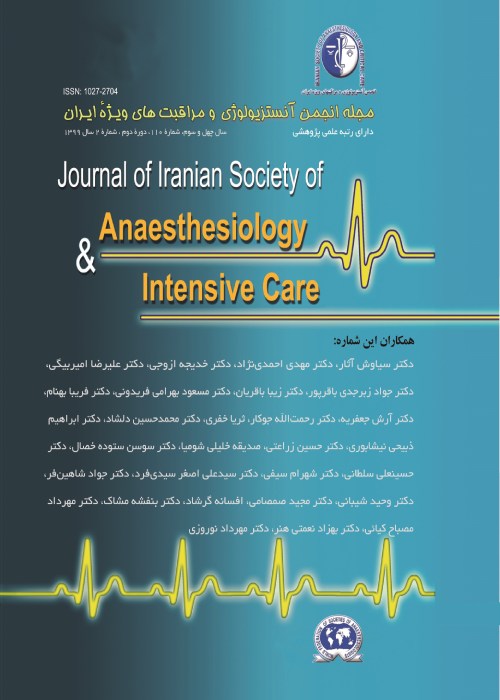فهرست مطالب

فصلنامه آنستزیولوژی و مراقبتهای ویژه ایران
سال سی و چهارم شماره 1 (پیاپی 77، بهار 1391)
- 80 صفحه،
- تاریخ انتشار: 1391/04/05
- تعداد عناوین: 12
-
-
سرمقاله: راهنمای کامل نویسندگان مقالاتصفحه 2
-
بررسی تست رمی فنتانیل قبل از عمل در تعیین دوز مخدر مورد نیاز و عوارض جانبی آن در بیماران تحت سنگ شکنی (مطالعه هم گروهی)صفحه 5
-
صفحه 74
-
صفحه 78
-
Page 13IntroductionConcerning the limitations in monitoring the depth of anesthesia, invention and improvement of devices for monitoring the depth of anesthesia has always been one of the most important priorities in anesthesiology in recent years. Since the invention of these devices, all of them worked on a quantitative basis, so we decided to obtain a theoretic model using Electroencephalogram signals for evaluating the depth of anesthesia during isoflurane maintenance.Materials And MethodsForty patients ASA class I, II between 15-65 year-old candidate for less than 3 hours surgery were chosen randomly. Induction for all of the patients was the same. EEG data were obtained and recorded one minute prior to induction up to the end of surgery and assessed using LILEY method. Thirty seven intervening parameters were concerned individually.ResultsThe required theoretic model was prepared and the effects of different parameters on model behavior, measured and identified.DiscussionThe presented model in this study, with a complex and flexible dynamic is able to simulate the human cortex under the influence of isoflurane. Despite the practical limitations, this study showed that it is possible to predict depth of anesthesia on a theoretic model. It seems that it could be used for a more precise monitoring of depth of anesthesia if improved.Keywords: Depth of anesthesia, electroencephalogram, isoflurane, general anesthesia
-
Page 21IntroductionPostoperative cognitive impairment is common in the elderly. Multiple factors such as anesthetic drugs are effective on postoperative cognitive function. Lidocaine is a drug used for different therapeutic targets in anesthesia. One of its indications is reducing airway irritations before extubation. This study is designed to evaluate the effect of bollous intravenous lidocaine at the end of surgery on postoperative cognitive function in the elderly undergoing urologic and orthopedic surgery with general anesthesia.Materials And MethodsIn this double blinded clinical trial, after permission from research committee and having obtained written consent, patients older than 65yr were devided in two equal groups (each group comparising of 35 patients). In case group, we used intravenous lidocaine 1.5mg/kg before extubation and in control group, normal saline was used. Cognitive state was evaluated by MMSE questionnaire at four stages: preoperative, at discharge time from recovery, 6hours and 24hours after surgery. Finally, data were analysed with ANOVA, T-test and Mann-Whiteny test.ResultsTwo groups had no significant differences in demographic factors, surgery status, past history of HTN, DM and smoking. Mean of MMSE at the time of discharge from recovery was 22.4±4.5(SD) and 22.1±4.4(SD) in lidocaine and normal saline group respectively. It showed significant differences with MMSE at the time of before surgery and 24 hours after surgery within two groups, but there was no significant differences in MMSE before surgery, at discharge time from recovery,6hours and 24hours after surgery between two groups. Frequency of severe cognition impairments in lidocaine group before surgery, at discharge from recovery room, 6hours and 24 hours after surgery was 8%, 17%, 9%, 6% respecttively. This frequency was 0%, 20%, 17%, 3% respectively in normal saline group. Two groups showed no significant differences in cognitive impairments at before and after surgery.Conclusion andDiscussionAdministration of bolous intravenous lidocaine before extubation didnot improve cognition state in elderly undergoing noncardiac surgeries under general anesthesia. The effect of lidocaine on cognitive function following cardiac surgeries in which the brain is at potential risk is clear, but in noncardiac surgeries where the brain is not at risk of ischemic events, lidocaine showed no clinical effects. Thus further studies with different doses of lidocaine and different assessment methods are recommended.Keywords: Lidocaine, cognition, dysfunction, postoperative, elderly
-
Page 30IntroductionPain is a frequent problem experienced in critically ill patients in the intensive care unit (ICU). Pain may increase morbidity and mortality and may decrease the comfort of patients and health-related quality of life. The adequate use of analgesics and sedatives therefore may decrease morbidity and mortality. The aim of this study is finding scientific evidence for parental paracetamol efficacy on pain intensity in ICU intubated patients underwent abdominal or pelvic surgery. Methods and materials: In this double bind controlled study, intubated patients aged 18-69 yr having undergone major abdomino-pelvic surgeries and transferred to icu were divided into two groups each comprising of 20. Group 1 upon arrival in ICU received 1G paracetamol diluted in 100 cc of normal saline. 6 hour by i.v. for 24 hrs and group 2 received 100 cc of normal saline. Opioid consumption and the intensity of pain scores based on BPS were assessed at 1, 2, 4, 6, 12 and 24 hrs after surgery. Data were analysed using spss 17.ResultsThe mean age of case and control group was 55.7 and 58.35 years. Frequency of men and women patients were 57.5 and 42.5. Pain intensity had significant difference in cases and control group at 1, 2, 4, 6, 12 and 24 hours (p=0.001). Also, opioid consumption after surgery had significant difference in cases and controls (p<0.01).ConclusionAccording to this finding, it is conducted that the parentral paracetamol is useful for pain reduction after surgery in ICU patients.Keywords: Abdominal, pelvic surgery, ICU, paracetamol
-
Page 37IntroductionAwareness under general anaesthesia can have some complications for the patients which might be very dangerous. One of the major operations in which awareness are very prevalent is Caesarean section. Because there is no objective methods to assess this complication, using cerebral state index (CSI) for decreasing the complications in caesarean sections has been studied in this paper.Materials And MethodsIn this clinical trial study, 290 pregnant women, 20-40 years old with normal body mass index, and ASA classification 1 or 2 after taking written consent were enrolled to this study. During the anaesthesia, cerebral state index was maintained between 40 and 60 when possible ant it was recorded at different stages of anesthesia. Induction of anaesthesia was provided by sodium thiopental 5 mg/kg and succinylcholine 1.5 mg/kg and maintenance of anaesthesia provided with N2O: O2 in 50% concentration, midazolam 0.02 mg/kg, morphine 0.1 mg/kg, fentanyl 2μg/kg and propofol to maintain CSI between 40-60. For evaluation of awareness modified Brice questionnaire and for statistical analysis T-test or Chi-square test was used.Results7 out of 270 patients had dreams after being awakened, but none of them were related to the events in the operating theatre.DiscussionPrevalence of awareness in this study correlated with other studies in which awareness was least 3%, but less than some studies in which it was about 6-10%.ConclusionCerebral state index could decrease awareness during anaesthesia, but in this study, its use was not able to completely eliminate it.Keywords: cesarean section, awareness during anesthesia, cerebral state index
-
Page 45IntroductionThe upper abdominal operations change postoperative pulmonary function tests. The postoperative pulmonary function tests are restrictive substantially. Peak Expiratory Flow (PEF) decrease in the restrictive lung disease. Laparoscopy causes physiologic changes in the respiratory system too and diaphragmatic function is impaired extensively after laparoscopy. The factors that cause aggravation of restrictive lung disorders increase postoperative lung complications.Materials And MethodsIn this randomized clinical trial thirty patients were ASA class I, II suffering from chronic cholecystitis due to gall stone allocated randomly into group I (open cholecystectomy with 15 patients) and group II (laparoscopic cholecystectomy with 15 patients). The PEF was measured one day before operation and in recovery room and 24 and 48 hours postoperatively in semisitting position. Collected data was analysed by SPSS. 17 software using t test, chi square test and analysis of variance. A p value <0.05 was considered as significant.ResultsNo difference was demonstrated between two groups with respect to their gender, age, ASA class, BMI and smoking (p> 0.05). Preoperative PEF in the group I (OC) was 353±34 (lit/min) and in the group II (LC) was 351±39 (lit/min) and without significant difference between groups (p= 0.92). The PEF on recovery, at 24 and 48 hours postoperative showed 52%, 48% and 42% reduction in the group I (OC) and 41%, 27% and 12% reduction in the group II (LC) respectively (p= 0.0001).ConclusionPulmonary function after laparoscopic cholecystectomy is impaired extensively but lesser than after open cholecystectomy. Pulmonary function impairment after open cholecystectomy increases till 24 hours after postoperative period but pulmonary function improves extensively 24 hours after operation in laparoscopic cholecystectomy.Keywords: Laparoscopic cholecystectomy, postoperative pulmonary function, peak expiratory flow
-
Page 53IntroductionThere has been an increasing interest to a combination of ketamine and propofol (ketofol) in recent years. It seems that ketamine increases blood pressure and attenuates hemo-dynamic effects of propofol. The sedative effect of ketamine lowers propofol dose in combi-nation which can reduce the incidence of apnea. The other point is that propofol has the antiemetic and strong sedative effects thus reducing the psychiatric adverse effects of ketamine. There are many uncontrolled studies about ketofol combination and its sedative effect and in the other controlled clinical trials the results were controversial.AimsComparison of Ketofol (Ketamine-Propofol combination) with Propofol for sedation during hysteroscopy.Materials And MethodsIn a double blind clinical trial patients were divided into two groups (n=20). One group was sedated with propofol and the other received ketofol. Vital signs and BIS (Bispesteral Index Score) were recorded before induction and after the patients sedated to a Ramsey Sedation Score of 6. Vital signs, side effects & duration of recovery were compared in both groups.ResultsDemographics and vital signs were the same before induction in two groups. There were no significant differences about BIS and hemodynamic changes between groups (p values respectively 0/29, 0/83 and 0/75). Incidence of apnea and side effects in recovery were similar in both groups. Recovey period was significantly longer in ketofol group than propofol group (p=0/008).ConclusionIt can be concluded from the present study that there are no differences between ketofol and propofol alone as regards deep sedation in young ASA I and II patients undergoing outpatientsurgery. Ketofol prolongs recovery period which suggests that ketofol is not an appropriate drug for outpatients sedation. There is no significant hemodynamical difference between ketofol and propofol for deep sedation.Keywords: Ketamine, Deep Sedation, Propofol, Diagnostic Hysteroscopy
-
Page 61IntroductionPain relief after laparoscopic cholecystectomy will help to provide the general goals of this surgical method. We conducted this study to investigate influence of intraperitoneal bupivacaine on visceral and shoulder pain with bupivacaine infiltration in abdominal wall incisions in both study and control groups in order to obscure somatic pain.Materials And Methods66 patients scheduled for laparoscopic cholecystectomy were randomly divided into two groups. Anesthesia induction was the same in both groups. In study group, 20cc of 0.25% bupivacaine was injected into peritoneum at the beginning and at the end of surgery by the surgeon under direct vision. After taking out the trocars, 5cc bupivacaine 0.25% was injected into each surgical incisions of abdominal wall in both studied and control groups. Within first four hours after operation, intensity of pain at 1 hour intervals, time of patient's request to extra narcotic (Tramadol) and total narcotic dose were recorded.ResultsNo statistically significant differences (p<0.05) were observed between both groups in compared parameters such as intensity of pain at 1st, 2st, 3st, 4st hour after operation, average time of narcotic request and total consumed narcotic.ConclusionThis study didn not confirm the usefulness of intraperitoneal bupivacaine as a pain relief method after laparoscopic cholecystectomy.Keywords: Laparoscopy, intraperitoneal bupivacaine, postoperative pain
-
Page 69Spinal cord lesions can occur due to various reasons and in different parts of the spinal cord. Depending upon the site of spinal cord lesion, it can produce different clinical presentations for the patient. Thus important strategies are required during the perioperative period to prevent cardio-pulmonary arrest in these patients. The case is a 48 year old woman who developed a cardio-pulmonary arrest during surgical removal of a spinal cord tumor.Keywords: Spinal cord tumor, cardio, pulmonary arrest, surgery


